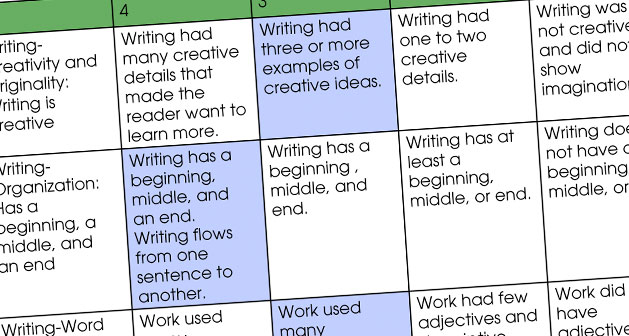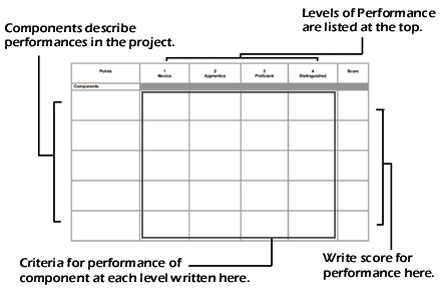
Make assessment a classroom conversation

A rubric is an assessment tool that clearly outlines expectations for student work. A rubric describes which performances will be assessed and specifies the criteria for assessing them. Rubrics can be used throughout the process of student work, making them useful for project-based learning implementations.
Because rubrics describe what high performance looks like, they are great tools to help students gauge their work and provide an opportunity for conversation between students and teachers about high-quality work.
Creating a rubric for the final product and various components of project work can ensure a more accurate, specific, and useful assessment.
A rubric is an authentic assessment tool that:
Rubrics address the work that will be done, focusing on the positive potential of future performance. They should be shared with students before a project is initiated. Students can refer to the rubric to see what they will be assessed on during the project as well as HOW they must perform in order to achieve the specific grade or assessment they want.
Sharing and clarifying the performances that will be assessed during a project removes mystery from the evaluation process, helping students focus on specific actions they can take to maximize their performance.
A rubric consists of the components that will be assessed, levels of performance, criteria that describe performances at different levels, and scoring. These items are usually organized as a table.

The components of your rubric may vary depending on the goals you have for the project your students are completing. However, if you are focusing on processes like writing and research, utilizing the same rubric provides consistency and a common language you can use to help students understand goals and work to reach them.
Rubrics are helpful in quantifying a range of digital products and real-world tasks. Be sure to consider the effectiveness of communication in the performance as well as competencies, or soft skills, gained.
Meeting curriculum goals and standards is always an important part of project work. Assessment should reflect the topic and project goals, and include specific criteria that meet curriculum standards and knowledge requirements. Content requirements may also include quality of research, the use of accurate and respected sources, and proper citation.
Any content, no matter how good, will lose its impact if it is not communicated clearly. Effective communication, whether in text, visual, or auditory formation, should be included as part of the rubric's assessment. Effectiveness of communication may also include clarity of navigation, impact of design, consistency, clear writing, visual communication, and grammar, punctuation, and spelling.
Rubrics are also useful tools for evaluating essential 21st century skills. As you develop your rubric, consider NCREL's enGauge 21st Century Skills, including:
A rubric should have three or four levels of performance. These can be described numerically or with descriptive terms such as Novice, Apprentice, Proficient, and Distinguished. How you describe these levels should reflect the age and literacy levels of your learners as well as the culture of your learning environment.
What you call each level is up to you, but make sure it is understood by your students. The distance between each level must be equal. Students should be able to identify incremental and achievable changes in performance that will help them move from lowest to highest.
Since many performances cannot easily be quantified, rubrics should be as specific as possible. Avoid relative terms like poor, fair, good, or excellent. Instead, use unique descriptions to describe work done at each level.
For example, a rubric about oral presentations should describe what posture, clarity, eye contact, attire, and loudness look like at various levels of performance.

How you score a rubric will depend on the learning goals for the project. You may choose to always award points for performance at a particular level. For example, a performance at the Novice level might always be worth one point, Apprentice worth two points, Proficient worth three points, and Distinguished worth four points.
You may also want to weight some performances differently to show that some components are more important than others. For example, you might value a Proficient performance for Spelling and Grammar at three points while valuing a Proficient performance for Quality of Research and Content at six points. This would indicate that for this project, you are more concerned about content and are placing less emphasis on grammar.
Rubrics are time-consuming to create, but that work can yield high dividends. Once you have developed a few rubrics, it becomes easier since you can copy and paste components and criteria from one rubric to another. Some digital tools, like Wixie, include built-in rubrics you can edit and customize, helping you get started and save time with this valuable skill.
Regardless of whether you're making your own rubrics or utilizing existing examples, be sure to use rubrics to make assessment a classroom conversation during project work. These discussions ensure students have accurate expectations and help you make project evaluation a shared responsibility with your students.
Creative Educator can help you bring project-based learning to your school.
Learn MoreFive ideas for creative classroom centers
Creative, digital book reviews
Fun and powerful ideas with animated characters

Wixie
Share your ideas, imagination, and understanding through writing, art, voice, and video.

Rubric Maker
Create custom rubrics for your classroom.

Pics4Learning
A curated, copyright-friendly image library that is safe and free for education.

Wriddle
Write, record, and illustrate a sentence.

Get creative classroom ideas delivered straight to your inbox once a month.
Topics